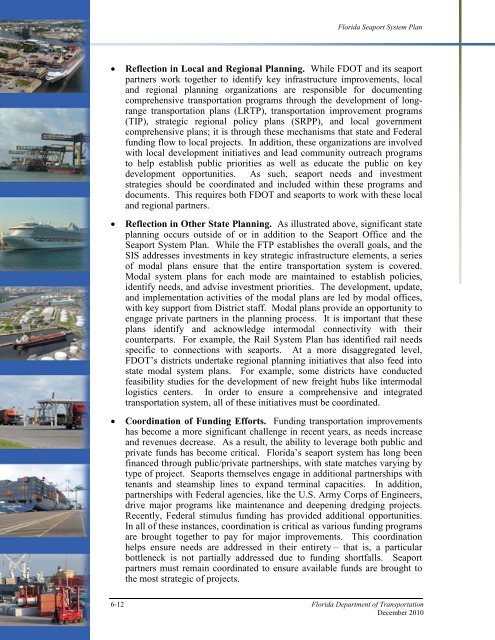Florida Seaport System Plan - SeaCIP
Florida Seaport System Plan - SeaCIP
Florida Seaport System Plan - SeaCIP
You also want an ePaper? Increase the reach of your titles
YUMPU automatically turns print PDFs into web optimized ePapers that Google loves.
<strong>Florida</strong> <strong>Seaport</strong> <strong>System</strong> <strong>Plan</strong><br />
• Reflection in Local and Regional <strong>Plan</strong>ning. While FDOT and its seaport<br />
partners work together to identify key infrastructure improvements, local<br />
and regional planning organizations are responsible for documenting<br />
comprehensive transportation programs through the development of longrange<br />
transportation plans (LRTP), transportation improvement programs<br />
(TIP), strategic regional policy plans (SRPP), and local government<br />
comprehensive plans; it is through these mechanisms that state and Federal<br />
funding flow to local projects. In addition, these organizations are involved<br />
with local development initiatives and lead community outreach programs<br />
to help establish public priorities as well as educate the public on key<br />
development opportunities. As such, seaport needs and investment<br />
strategies should be coordinated and included within these programs and<br />
documents. This requires both FDOT and seaports to work with these local<br />
and regional partners.<br />
• Reflection in Other State <strong>Plan</strong>ning. As illustrated above, significant state<br />
planning occurs outside of or in addition to the <strong>Seaport</strong> Office and the<br />
<strong>Seaport</strong> <strong>System</strong> <strong>Plan</strong>. While the FTP establishes the overall goals, and the<br />
SIS addresses investments in key strategic infrastructure elements, a series<br />
of modal plans ensure that the entire transportation system is covered.<br />
Modal system plans for each mode are maintained to establish policies,<br />
identify needs, and advise investment priorities. The development, update,<br />
and implementation activities of the modal plans are led by modal offices,<br />
with key support from District staff. Modal plans provide an opportunity to<br />
engage private partners in the planning process. It is important that these<br />
plans identify and acknowledge intermodal connectivity with their<br />
counterparts. For example, the Rail <strong>System</strong> <strong>Plan</strong> has identified rail needs<br />
specific to connections with seaports. At a more disaggregated level,<br />
FDOT’s districts undertake regional planning initiatives that also feed into<br />
state modal system plans. For example, some districts have conducted<br />
feasibility studies for the development of new freight hubs like intermodal<br />
logistics centers. In order to ensure a comprehensive and integrated<br />
transportation system, all of these initiatives must be coordinated.<br />
• Coordination of Funding Efforts. Funding transportation improvements<br />
has become a more significant challenge in recent years, as needs increase<br />
and revenues decrease. As a result, the ability to leverage both public and<br />
private funds has become critical. <strong>Florida</strong>’s seaport system has long been<br />
financed through public/private partnerships, with state matches varying by<br />
type of project. <strong>Seaport</strong>s themselves engage in additional partnerships with<br />
tenants and steamship lines to expand terminal capacities. In addition,<br />
partnerships with Federal agencies, like the U.S. Army Corps of Engineers,<br />
drive major programs like maintenance and deepening dredging projects.<br />
Recently, Federal stimulus funding has provided additional opportunities.<br />
In all of these instances, coordination is critical as various funding programs<br />
are brought together to pay for major improvements. This coordination<br />
helps ensure needs are addressed in their entirety – that is, a particular<br />
bottleneck is not partially addressed due to funding shortfalls. <strong>Seaport</strong><br />
partners must remain coordinated to ensure available funds are brought to<br />
the most strategic of projects.<br />
6-12 <strong>Florida</strong> Department of Transportation<br />
December 2010
















